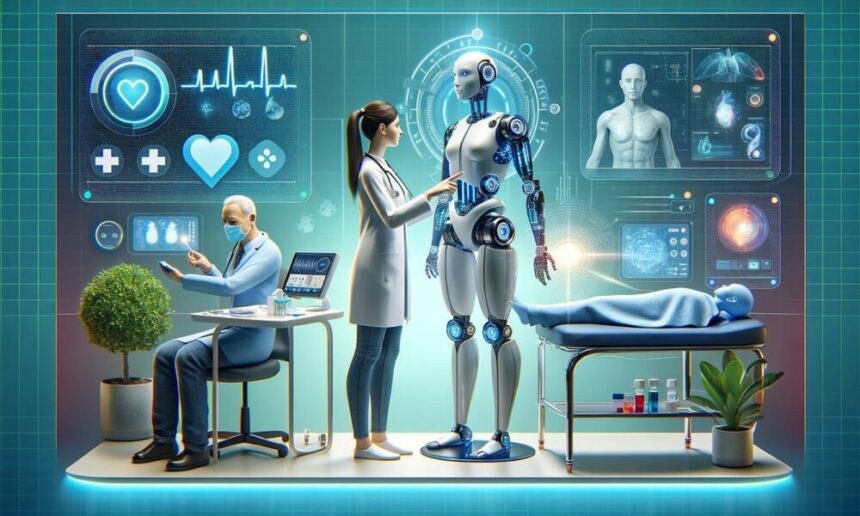The healthcare industry is undergoing rapid technological transformation, paving the way for improved patient care and operational efficiency. Today’s patients are more informed and engaged than ever before. They expect a seamless care experience that prioritizes not just clinical excellence but also factors like convenience, communication, and empathy. To meet these expectations, healthcare providers need to optimize their operations, invest in patient-centric technologies, and develop data-driven strategies. Here are the key technology trends that are shaping healthcare in 2024:
1. Artificial Intelligence (AI) and Machine Learning (ML)
Applications in Diagnostics and Treatment: AI and ML are revolutionizing healthcare by enabling accurate and early detection of diseases. These technologies analyze medical images, predict patient outcomes, and recommend personalized treatment plans. AI-driven diagnostic tools, such as IBM Watson Health, assist healthcare providers in making data-driven decisions, leading to better patient outcomes.
Operational Efficiency: AI streamlines administrative tasks, from scheduling appointments to managing medical records. By automating routine tasks, healthcare professionals can focus more on patient care, reducing burnout and increasing productivity.
2. Cloud Computing
Data Storage and Accessibility: Cloud computing ensures secure, scalable storage solutions for patient data. It facilitates seamless access to medical records, enabling healthcare providers to share information quickly and efficiently. This is crucial for collaborative care, especially in multi-disciplinary treatment plans.
Cost-Effectiveness: Cloud-based solutions reduce the need for expensive on-premises hardware, lowering operational costs. Healthcare organizations can allocate resources to other critical areas, enhancing overall service delivery.
3. Internet of Medical Things (IoMT)
Connected Devices: IoMT encompasses a network of connected medical devices, such as wearables, implantables, and home monitoring systems. These devices collect real-time health data, allowing for continuous monitoring of patients’ conditions.
Personalized Healthcare: The data collected by IoMT devices is analyzed to provide personalized treatment plans. For instance, continuous glucose monitors help diabetic patients manage their condition more effectively by providing real-time insights into their blood sugar levels.
4. Augmented Reality (AR), Virtual Reality (VR), and Mixed Reality (MR)
Enhanced Medical Training: AR, VR, and MR technologies are transforming medical education by providing immersive training experiences. Medical students and professionals can practice surgeries and procedures in a virtual environment, enhancing their skills without risking patient safety.
Improved Patient Care: These technologies are also used in patient care, such as AR-assisted surgeries and VR therapy for pain management and mental health treatments. They offer innovative ways to treat patients and improve their quality of life.
5. Big Data Analytics
Comprehensive Data Analysis: Big data analytics allows healthcare providers to analyze vast amounts of data from various sources, including electronic health records (EHRs), wearable devices, and genomic data. This comprehensive analysis helps in identifying patterns and trends, leading to more accurate diagnoses and treatments.
Population Health Management: Big data is instrumental in managing population health by tracking disease outbreaks, assessing risk factors, and developing preventive strategies. Healthcare organizations can tailor interventions to specific populations, improving public health outcomes.
6. Telemedicine and Telehealth
Remote Healthcare Services: Telemedicine and telehealth services have gained significant traction, especially in the wake of the COVID-19 pandemic. These services allow patients to consult healthcare providers remotely, reducing the need for in-person visits.
Increased Accessibility: Telehealth expands access to healthcare for patients in remote or underserved areas. It also provides convenient options for patients with mobility issues or chronic conditions, ensuring they receive timely care without the hassle of travel.
7. Nanomedicine
Targeted Drug Delivery: Nanomedicine involves using nanotechnology for precise drug delivery and treatment. Nanobots can deliver medication directly to affected cells, minimizing side effects and enhancing treatment efficacy.
Early Disease Detection: Nanotechnology is also used in diagnostic tools that detect diseases at an early stage. For example, nanoprobes can identify cancerous cells before they form tumors, allowing for early intervention and better prognosis.
8. Robotics and Healthcare Automation
Surgical Precision: Robotic-assisted surgeries are becoming increasingly common, offering higher precision and reduced recovery times. Robots like the Da Vinci Surgical System perform complex procedures with minimal invasiveness, improving patient outcomes.
Automated Administrative Tasks: Robotics also automate administrative tasks such as patient check-ins, billing, and inventory management. This reduces the burden on healthcare staff and increases operational efficiency.
9. Organ Care Technology and Bioprinting
Organ Preservation: Advanced organ care technologies improve the preservation and transportation of organs for transplantation. Devices like the Organ Care System keep donor organs viable for longer periods, increasing the success rates of transplants.
3D Bioprinting: 3D bioprinting is revolutionizing tissue engineering by creating living tissues and organs. This technology has the potential to address the shortage of donor organs and pave the way for personalized medicine.
10. Smart Implants
Real-Time Health Monitoring: Smart implants, such as cardiac pacemakers and orthopedic devices, monitor vital signs and transmit data to healthcare providers. This real-time monitoring enables timely interventions and improves patient outcomes.
Enhanced Recovery: Smart implants also aid in post-surgical recovery by providing continuous feedback on the healing process. Patients can receive personalized care based on their specific needs, accelerating recovery times.
11. Telepsychiatry
Accessible Mental Health Services: Telepsychiatry offers remote mental health services, including counseling and therapy sessions. This expands access to mental health care, particularly for individuals in remote areas or those unable to visit a clinic.
Convenience and Privacy: Telepsychiatry provides a convenient and private option for patients to receive mental health support. It reduces the stigma associated with visiting a mental health facility and encourages more individuals to seek help.
12. Chatbots and Virtual Healthcare Assistants
24/7 Patient Support: Chatbots and virtual healthcare assistants offer round-the-clock support, answering patients’ questions, assisting with diagnostics, and managing appointments. These tools enhance patient engagement and improve access to healthcare information.
Efficiency in Healthcare Delivery: By automating routine interactions, chatbots reduce the workload on healthcare staff and improve the efficiency of healthcare delivery. Patients receive timely responses and assistance, leading to higher satisfaction levels.
Embracing the Future of Healthcare
The integration of these cutting-edge technologies is driving a revolution in the healthcare industry. By adopting these innovations, healthcare providers can enhance service delivery, improve patient outcomes, and ensure a more efficient healthcare system. As we move forward, the focus will be on leveraging these technologies to create a patient-centric approach, ensuring that healthcare is accessible, affordable, and effective for all. For more information on how to adopt these technologies, consider exploring strategic partners that can offer you expert Healthcare Software Development Services.
Read more from techbullion








